#Elite Cultivation
Explore tagged Tumblr posts
Text



Strain: Donny Burger
Grower: Elite Cultivation
State: Oklahoma
Medical/Recreational: Medical
#cannabis#cannablr#Donny Burger#cannabis strain#cannabis strains#mine#cannabis community#cannabis content#Elite Cultivation#Oklahoma#medicinal herbs#medical marijuana#medical cannabis#cannabis cultivation#cannabis culture
751 notes
·
View notes
Text


i have HIGH hopes
#cannabis community#cannabis#cannablr#Donny Burger#cannabis strain#cannabis strains#mine#cannabis content#Elite Cultivation#Oklahoma#medicinal herbs#medical marijuana#medical cannabis#cannabis cultivation#cannabis culture#wearyelfphotos#cannacommunity#cannalife#pretty bud#pretty nugs#1950s#weedlife#420friendly#60s#girls who smoke weed#marihuana#weedsociety#sativa#weed#kush
3 notes
·
View notes
Text
Some people don't seem to realise that if not for Jiang Fengmian bringing Wei Wuxian to Lotus Pier, Wei Wuxian and Jiang Cheng would never have been friends (or friendly). I would even argue that Wei Wuxian would be nicer to Jin Zixuan than Jiang Cheng. Why? Because Jin Zixuan at least has some honour. A scene that illustrates this better than anything is the Xuanwu cave. Who went against the Wen to help Mianmian? Wei Wuxian, Lan Wangji and Jin Zixuan! And how did Wei Wuxian react to that unexpected turn of events? He praised him! (Well, kinda)
Jin ZiXuan lifted his brows, “Is that enough? It wasn’t enough for people to be flesh shields for you, and now you want live humans to bleed for you to use as bait?!”
Wei WuXian found this somewhat surprising, So Jin ZiXuan really does have some nerve.
ExR. ch. 52 (original emphasis)
And what was Jiang Cheng doing? Trying to "reign" Wei Wuxian in so that he "doesn't stir up trouble". Why did he not go against the despicable Wens as well? Let me use his own words:
Jiang Cheng warned, “We aren’t even able to care for ourselves; how do we have the time to care about the trivialities of others?”
And Wei Wuxian's response:
Wei WuXian, “First, this isn’t a triviality. Second, things like this, somebody will have to care about them, sooner or later!”
ExR. ch. 52
And Wei Wuxian doesn't say this because they're talking about Lan Wangji and burning of Cloud Recesses. This is the fundamental difference between them. Jiang Cheng is too self-absorbed to care about others (unless they are related to him by blood), while Wei Wuxian wants to help everyone if he is able to, not because he "has a hero complex", but because that's the right thing to do.
People can be friends with others while having different ideas, but when you disagree on the core beliefs, friendship is hard to achieve.
#mdzs#wei wuxian#jiang cheng#canon jiang cheng#if they didn’t grow up together jc wouldn't want to be his “friend” either#because gentry doesn’t muddle with “riff-raffs”#just read ch. 51#madam yu is the prime example of what gentry thinks of servants#wei wuxian would’ve never met the end he did if he was part of the elite or didn’t go against them#cause how dare he a mere son of a servant#btw this excerpt from ch. 8: “The thing that Jiang Cheng hated the most was to be disadvantageous during a fight.”#jc (and everyone else in the cultivation world) wouldn’t have gone against wens#if they hadn't attacked/annihilated three great clans first
188 notes
·
View notes
Text
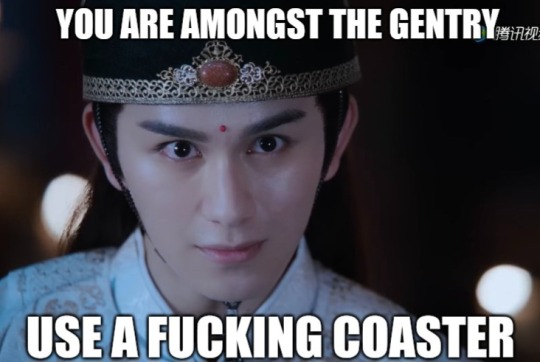
heard his voice when I was in a meeting with the vice presidents of the credit union and was the only one who didn't set my water bottle on their custom quartz coasters
then I had more idea :)
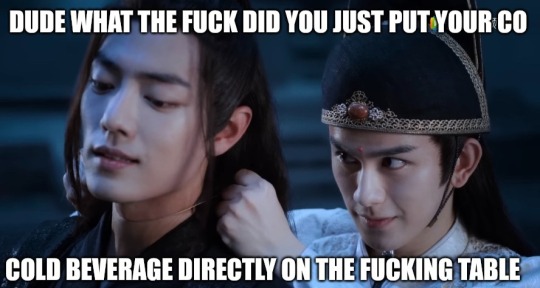
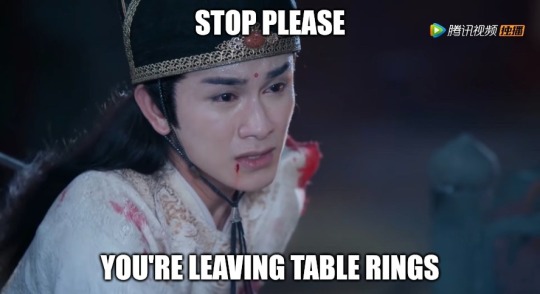
#mdzs#mo dao zu shi#gdc#grandmaster of demonic cultivation#the untamed#cql#chen qing ling#jin guangyao#jgy#meng yao#thank you a-yao for saving me from looking like a fool in front of the Middle-Aged Elites#also#blood#bc i noticed some ppl tag it on reblogs and i didn't even consider it as a cw#my bad!!
396 notes
·
View notes
Text
magic in asoiaf is genetic. and that is intresting. and the fact that grrm doesn’t shy away from the implications of this makes me love asoiaf even more.
because it’s very understandable that these people who could ride dragons would see themselves as more gods than men. it’s understandable that the practice of sibling-sibling incest would become common in order to keep this ability in the family/to not lose said ability. it’s also understandable that these people would see their race as superior because they are able to do these things that others could not.
it also makes complete sense that this human civilization collapsed in a horrific magical event due to their own hubris because they saw themselves as gods when they were always only men.
and that is peak world building.
some more peak world building is that the noble houses of westeros also clearly gained power and held onto their power through the use of their magical abilities inherited from their ancestors.
a godlike existence like Garth the Green being the ancestor of all the oldest and most noble of the reach houses makes perfect sense for this world!and it also makes sense that the lords without this ancestry are discriminated against in this region that still holds onto the values their society cultivated in the past in order to maintain their magical superiority, even though most of these noble and old houses no longer exhibit these abilities.
and it also makes sense that these people no longer have access to these abilities as they no longer practice the religion that was centered around these powers; plus their blood is simply diluted at this point as these houses have married into a different ethnic group so often that the magical gene just doesn’t surface anymore.
but the fact that it still matters if you can trace your ancestry back to Garth the Green? peak! peak! peak!
george does such an excellent job showcasing the stagnation of westerosi society here because why should it matter if you’re connected to this magic guy if magic is no longer commonplace? however, it also makes total sense that the ruling class of the reach still harps on and on about this as it’s how they maintain the status quo and differentiate themselves from those they consider lesser now that they no longer have access to magic themselves.
and this is also why it’s very important that the Starks still retain the blood of the first men. because the first men interbred with the children of the forest and other elder races, which is what gave these humans these powers. it’s also worth noting that before the direwolves connected with the Stark children, none of our current Starks were able to awaken their abilities by themselves, which shows that even now they are very far removed from their ancestor who’s genetic makeup gave this bloodline these abilities. and it makes sense that the Starks experienced this slow magical decline because magic itself was declining in the world after the doom of valyria.
another reason for this decline is because Andal culture started heavily influencing the North and slowly changed the way magic was perceived. so now in the present, a warg/skinchanger/greenseer has become something to fear being because that’d make you different and therefore puts your life at risk, which means that there’s now practically no safe environment to cultivate these abilities and no secure way to pass down any knowledge you do have about said abilities.
i can’t help but be reminded about how Jon Snow has rejected his nature and how that has led to the stagnation of his abilities, and then i think about Arya and Bran and how their new environments have led to an astonishing growth in their abilities, which shows that it’s not just genetics that matter, environment is also just as, if not more, important.
i bring all of this up because magic being genetic in asoiaf is not as problematic as people try to make it out as. in real life, sometimes people just have genetic gifts. some people can become olympians, and some people are disabled. some people are born 10 times smarter than the average human, and some people believe that covering their faces in lemon juice would turn them invisible. that is reality. and in this universe, some people have access to magic and some don’t, and it’s all based on genetics. it’s unfair! and that makes it realistic.
not everyone gets to ride dragons and not everyone gets to travel back in time, and that grounds asoiaf, which is what grrm was going for.
and how these societies have organized themselves in response to these genetic abilities and the dangers they pose makes absolute sense. on one hand we have the valyrian freehold, which was a magic hotspot and the people who lived there used magic to propel their society to new heights, and on the other hand we have the seven kingdoms that demonize anyone too different, and all magic practitioners are different from normal humans.
and the fact that george decided to go this route with asoiaf is so juicy to me cause:
we have characters like Varamyr and Euron who use their abilities to commit great evils and we know that their powers have influenced the way they see and interact with others. on the other hand we have characters like Dany who use their abilities to fight against evil violent institutions. and through characters like her we learn how vulnerable fledgling magic practitioners/characters with these abilities are to these older and more dangerous institutions and individuals who are perfectly aware about the knowledge gap between them and these younger characters and know exactly how to exploit them.
so, while it’s understandable that the fandom is uncomfy with the practices and values that grrm has written about, this isn’t bad world building by any means. it’s logical and well thought out. and i truly enjoy that grrm doesn’t shy away from writing about the more worrying aspects and implications of magic being a matter of genetics. i also like how the seven kingdoms and the valyrian freehold are kinda extremes on the matter of magic and how this is/was detrimental to both of these societies and at the individual level. a horrific magical firey doom is not any better nor any worse than a slow drawn out icey decline.
imo, what is important to remember is that in the world of asoiaf, people with magic are the ones who are discriminated against (bc most POV characters are in Westeros and magic is a no no there). so they are the ones who are in danger if they out themselves as magic users. now, it is true that some societies are more tolerant (Qarth is a great example of this and Valyria before the doom was likely the most tolerant to have ever existed in this world), but as of now most societies simply aren’t. remember jojens warning? he didn’t pull that out of his ass. bran would’ve been in a lot of danger if he came out and told the wrong people about his dreams/abilities. also, jon’s assassination may have been partly motivated by the mutineers fear of wargs. this is the life-threatening danger magic practitioners are in for simply existing in an intolerant society.
tbh the reason i typed all this up is because it’s very annoying when people try to ignore the reality, which is that the dragonbond depends on genetics. now, i’m sure there are other ways to ride a dragon, as dragons are magical animals so of course there may be a one in a million chance of a dragon allowing some rando to ride it, but this doesn’t change the fact that there is such a thing as a genetic ability that gives these certain humans the ability to form a connection with a dragon.
(another example that i can’t help but remember is that melisandre was able to get ghosts approval by using some of her tricks. of course there could be other reasons for ghost to have done this, but the most likely reason is that ghost simply fell for melisandre’s trick and this influenced how jon saw mel. but this doesn’t change the fact that melisandre will never have the kind of bond jon and ghost have because melisandre is not a warg. this is also another example of how vulnerable fledgling magic practitioners are to older ones.)
so, sorry not sorry that george decided to create a realistic representation of what a society would look like if only certain bloodlines were able to ride dragons <\3.
#this is interesting! it’s juicy! because these are humans with the power of gods!#of course there was a civilization where the elites saw themselves as gods!#of course their powers impacted the way they structured their society!#of course the stagnant westerosi society still holds onto values and practices from hundreds of years ago#…because they once had magical abilities that set them apart. and bc their society is so stagnant they still have these values and practices#…after they lost their magical abilities. and it makes complete sense that these magical abilities were lost!#magic is feared in westeros! anyone with these abilities is othered/an outcast. these inherent powers aren’t cultivated bc this is a society#…that fears and persecutes people with magic! and it makes total sense that this likely began with the arrival of the andals!#anyways magic is genetic ✌️#and it’s so cool that so many people in this universe may not know that they have these powers bc they live in a society that doesn’t care/#doesn’t cultivate said powers. jon snow is literally called a beast by other characters bc they think he’s a warg#westeros is not a safe space for my magical son#i’m ready to fight anyone who disagrees#it’s literally so fucking intresting and i’m glad that george doesn’t shy away from any of it#asoiaf#pro targaryen#asoiaf meta#also let’s not pretend that warging/greenseeing hasn’t been used for horrible things as well#hodor is right there. legends of the nights king show exactly what can happen when a very powerful greenseer is a horrific human#yeah anyways#maybe he wasn’t a greenseer but u get my point (i hope)#asoiaf fandom critical#ppl having issues w/ the dragonbond being genetic has always struck me as odd#but i’d lie if i said i didn’t know where this attitude came from#this whole post is a mess lmao#hopefully i got my point across but i dont rly care to edit ����♀️#this is def a word vomit
30 notes
·
View notes
Note
Hi there, I have a question that may seem mixed (its a bit culturally mixed in my head) I totally get that WWX wasn't adopted and so he didn't expect (or got) parental affection never something close to equal standing to the Jiang children. But, as a mere disciple, what were his responsibilities and rights and what was his sect leaders (shifu & shimu) responsibilities towards him or had the right (considered rightful) to demand of him as a child that joined their sect? Or to broad things to more than orphans (in case it doesn't weight there) what level of care should expect parents for their children once they joined a sect???
Was there an even remote Chinese equivalent to: "in loco parentis"?
I've answered a similar ask to this on the duties of a first disciple, since he was one. Truth is that we actually don't get the details of what was actually expected of Wei Wuxian (or any disciple, really) as disciples per the rules of their affiliated clans. As for the responsibility of the clan and clan leaders: the clan is meant to take care of you like family. If a family sends their child off to be the disciple of someone else's clan or sect and that clan or sect accepts them, the clan/sect is fully responsible for the care, education, and training of that disciple until the day that they separate from the sect or die. Same with orphans as with disciples who still have family outside. In other novels, the divide between orphaned and non-orphaned disciples could be a source of conflict (non-orphaned disciples in a sect might be the direct descendants of a cultivation clans or just have rich parents who send them material resources and offer prestige that an orphaned disciple would obviously have no access to other than through their own hard work). But mdzs isn't about the conflict in that way, especially since it operates with clans as the dominating organization system of the cultivation world, no longer sects.
For the Jiang in mdzs, their responsibilities towards Wei Wuxian as a ward and disciple were to make sure that he was clothed, fed, educated, and trained up in martial arts. Wei Wuxian would then, in turn, bring prestige to the clan with his skills and, as first disciple, help with other upkeep attached to that title (whatever they may be). The things that were not a part of his duties as disciple were: being close to the head family of the clan or being the clan heir's personal companion. Those came with him being the son of the clan leader's deceased close friend, not because he was a regular disciple.
#mdzs asks#krysaniar#hope this answers your questions#mdzs doesn't stray too far from other cultivator cnovels when it comes to some stuff#but because the system is based around *clans* and not sects#it makes it difficult to predict exactly *how* different things are without concrete details#and mxtx was just not interested in providing detailed explanations of how this switch from sects to clans#changed the overall martial sect structure the clans came from#but ultimately it also doesn't matter because mdzs isn't a novel mainly about cultivation#it's about the class politics and elitism undergirding it
21 notes
·
View notes
Text
Unsolicited CQL headcanon:
The reason Hanguang-jun isn’t stacked like a brick shithouse from all the Lan handstands (and why Wei Wuxian isn’t stacked from being a phenomenal archer) is that the typical cultivation method means they’re drawing their strength from their golden cores. So it’s not that they’re not incredibly strong, it’s that that strength does not translate into ✨Muscles✨
The Nie method, on the other hand, doesn’t work quite like that, so they DO end up swole af.
This also makes beauty standards somewhat skewed: in the broader cultivation world, looking waifish is seen as a desirable sign of higher cultivation, while the Nie have a Reputation (NMJ in particular)
#the untamed#cql#cw body image#in this house we Stan a STACKED nmj#yes I am calling out LXC and JGY here for being weird kinksters in this hc version of the cultivation world)#(if the YLLZ wasn’t starving he’d totally get stacked too is what I’m saying#RIP HGJ and his YLLZ kink lol#listen tho fr if you haven’t seen an elite martial artist in person before they have a Very Distinct musculature it’s fascinating#not abs but a TRUNK#(I am married to someone with the build of a Kenyan Marathonner if you look at the Olympic bodies photoseries)
0 notes
Text
Thank you for sharing your thoughts OP. It brought up a lot of feelings and thoughts in me, so I hope you won't mind my attaching some of them to your well-considered piece above.
I felt the same way after I graduated - my Arts degree is a double major in English and creative writing. I studied writing more broadly, both fiction and non-fiction, poetry, prose and playwrighting, for four years.
One of the things that really bothers me to think about now is the sneer that was consistently directed at genre fiction. In not so many words, it was literary fiction or trash. This trend was even worse when it came to poetry. Most of what we studied was just what you're talking about here - that is (I'm going to be blunt) wank.
Even knowing how to read and interpret it - I can sometimes get at the meanings in it, if there is any - I can write it - but with all due respect to those who love it, so much of it is just pretentious nonsense.
Over the years, I've heard so many people say they hate poetry, and I firmly believe this is why - this idea that literary poetry is the only legitimate form, while every other, easily understandable form, isn't really poetry at all. I find that a travesty really.
And sidebar to all this - when I think about traditional publishing, and how they favour this form of poetry and (here in Australia anyway) fiction, there are capitalistic overtones in it all that really suck. The message really is - Produce what is demanded by the machine or don't write.
For years after I got my degree, I felt creatively stunted. I felt compelled to be writing something very specific - and for me that was Australian, highly descriptive, hard hitting and concerned with social issues around post-colonialism. It had to be realism, of course, and it had to be literary - and when I tried to do anything else, it felt wrong. I'd internalised this sense that writing what I loved, as I wanted to write it, was failing to come up to some imagined mark of true art, true writing.
I endeavoured for a long time to do that - to write what I was 'supposed' to write. Then I stopped writing for two years. Eventually, I found my way back to myself as a writer.
Even so, there are still two wolves inside me (as the saying goes) - one that just wants to write for fun, to indulge in light genre fiction and prose poems that are only loosely poems, and vignettes just for the hell of it - and the one that is, frankly, intensely judgmental and says I shouldn't be wasting my time. I should be writing the timeless, "great Australian novel."
I'm glad to say that on most days, the non-judgemental wolf wins easily these days.
And I'm glad I did the degree. I learnt so much, got shaken out of my comfort zone in the best of ways, was exposed to so many ideas I would never have found for myself, and that make me the writer that I am now - but there's no denying that there's this negative side to it all which I don't see many people talk about.
I've been able to neither read nor write stories in a long time. Poetry too, for the most part. I guess what I mean is that the art of the written word has become a stranger to me.
I hate what poetry classes did to my writing. Yes, the Wikipedia poems, but they are easier because they're not my own words, and I have gotten so many comments on those saying they are powerful pieces of art, but for me personally they're a way of hiding from the awfulness of trying to assemble my own words into poetry.
I hate the poems I wrote in poetry classes. I hate the version of me I showed others in those classes. I hate the way poetry classes taught me to draw from my own experiences and thoughts for poetry. I hate everything I learned about how to interpret poetry, the eye with which I learned to read poetry, and the vocabulary I learned to talk about poetry, and ultimately, I hate "literary" poetry.
"Literary," by the way, is the category of art that has more meaning, value and legitimacy than the "other" category, which is not "literary." A "literary" poem is published in special, fancy "literary" magazines and almost invariably written by a person with a MFA or PhD in poetry.
You could say that the distinguishing feature of "literary" art is its overwhelming sense of legitimacy. A "literary" poem is a poem in the same way that a nonprofit organization is charitable, that a CEO is rich, or that an SAT score demonstrates your academic prowess. It is a poem completely immune to the possibility that someone will think it sucks. It expects to be absorbed, analyzed, studied, and discoursed upon because something feels "official" about whatever designates it as Good Art.
Literary poems are not only written by and for a special subset of people that have been formally taught to read and interpret poetry, they are written exclusively for audiences that will automatically assume they are Good Art; beautiful, meaningful, and worth interpreting. Because of this, most literary poems are literal incomprehensible nonsense.
Just take this one:
Say I climb the ladder of wheat/and at the top there is a faucet dripping beads of water/but the water takes a year to turn into an eagle/and the sky's forty-three shades of gray pierce/the first inflection of my heart, the point where the signals/throw grass into the river. Say the river sags/and the horizon sucks the lance out of the ghost's hands/like the moment of being born, the point where a shadow's/tongue slides through the faultline./Grace. Sunlight, cherries.
(it continues like this)
And conceptually, I love art as collaboration between the creator and viewer, where abstract, indeterminate and murky things are forced to take shape through the participation of the viewer as they interpret and associate things that stand out to them in the work! The "aliveness" of art in the abyss between what the artist attempts to communicate and what the viewer feels is the coolest thing to me!
But this philosophy of art is incompatible with the idea that there is an elite category of art that is worthy of interpretation, analysis, and reverence. I can fuck around with this random word generator and get something that is roughly as meaningful as the above. I don't mean that as demeaning to the poem, I mean that I feel demeaned by the poem, because its linguistic play and experimentation is something that everybody can do, that everyone should try doing, but this poem has been designated as something exceptionally meaningful and worthy and its writer teaches writing at the University of Chicago. You can click through that website for hours and not find a single soul without a MFA or above in poetry or creative writing.
For me, the world of "literary" writing was like a room with a splatter of vomit across the floor that no one else would acknowledge. The ability to formally study poetry in college was a privilege, but I was constantly aware of privilege, and the thing about privilege is the more you have, the less you think about it. What of the ability to pursue a PhD in poetry? What small fraction of people could expend so much time and money on something that didn't really have a career associated with it? And of that fraction, which fraction would be seen as "good enough" to publish poetry books and to teach? With poetry this indeterminate, how were the "good" poets selected at all?
Literary writing excludes poor people, and the existence of published literary poets who are immigrants or minorities doesn't negate this. Increasingly, published writing in general excludes poor people. A LOT of popular authors graduated from very elite schools!
But literary poetry I hate especially, because it puffs itself up on unlocking the universe and human experience and pain, as if insight into those things is a seldom-appearing gift instead of something many people have, except they don't have the time and money to train themselves into expressing it in a way that appears Literary.
The "literary" vs. "non-literary" paradigm had an inescapable rottenness to it. I couldn't stop thinking about the luminous conversations I'd had with people who lacked the formal training to express ideas in a "literary" manner, but still showed me something vital about the universe.
I've been bitching about literary poetry for like two years now, and really, I just hate what studying all that shit has done to my own writing style. It's so frustrating that the joy and playfulness won't come back.
#university#poetry#writing#behold the field in which i cultivate my vibes#elitism#high art#academia#PS. Uni degrees are state funded here so people without a lot of money#have access to higher education#it's very different to other parts of the world in that way#I am from a low socio-economic background myself#I have a large debt that I have to pay back if I earn over a certain amount per annum#but my degree cost me almost nothing
747 notes
·
View notes
Text
Nodal Dominant Themes — 𝐍𝐚𝐤𝐬𝐡𝐚𝐭𝐫𝐚 𝐎𝐛𝐬𝐞𝐫𝐯𝐚𝐭𝐢𝐨𝐧 𝐒𝐞𝐫𝐢𝐞𝐬 (part 1) 𝐨𝐟 𝐩𝐚𝐫𝐭 𝟓
Ardra, Swati, Shatabhisha embody Rahu qualities to the fullest. Breaking boundaries, whether they mean to or not, refining or rebuilding themselves by the way they absorb Maya (illusion), being thrown into foreign lands to create, explore and challenge existing paradigms. The ultimate mastery of Rahu nakshatras lies in recognizing that Maya is not the goal, but the process of refinement. This is shown in the natives' urge to learn, apply and cultivate something for themselves. This means that their initial stages have a lot of lack, and that's where that hunger to achieve and receive comes from. They'll take on challenges if it means there's an opportunity to fulfill themselves. In these following examples, the Rahuvian character is often given an opportunity to enter higher societies, usually through a job, a scholarship or from meeting the right person in the right time.
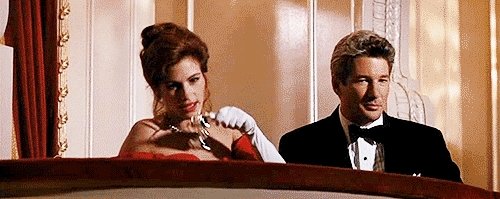
Swati Sun Julia Roberts, in Pretty Woman, plays a poor, sex worker who enters the high society through a billionaire and becomes 'refined'. Despite her glow up, her authenticity still contrasts with the pretentiousness of the high class social circle she finds herself in, challenging their perceptions of worth and class.
Much like Pretty Woman, in the film My Fair Lady, the Rahuvian meets a snobbish phonetics professor who wages that he can make her presentable in high society.


In the film Khoobsurat, Shatabhisha Moon Sonam Kapoor Ahuja plays a quirky physiotherapist who is ill-mannered and boundless. She is given a once-in-a-lifetime opportunity to work for a royal family. There, she meets a handsome young Rajput prince who is her complete opposite (given that he is portrayed by a Mula Moon native, Fawad Khan, who adheres to the customs of his background, bound by his roots).
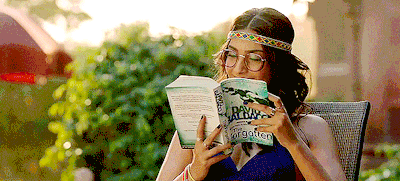
Despite their different social classes, the royal family learns a lot from her authenticity.
This theme of outer duality in which the native crosses over to a whole new world different from where they originally came from centers a lot around the 'poor vs rich' dynamic in these modern examples — exploring classism, elitism and other societal divisions which make outsiders.

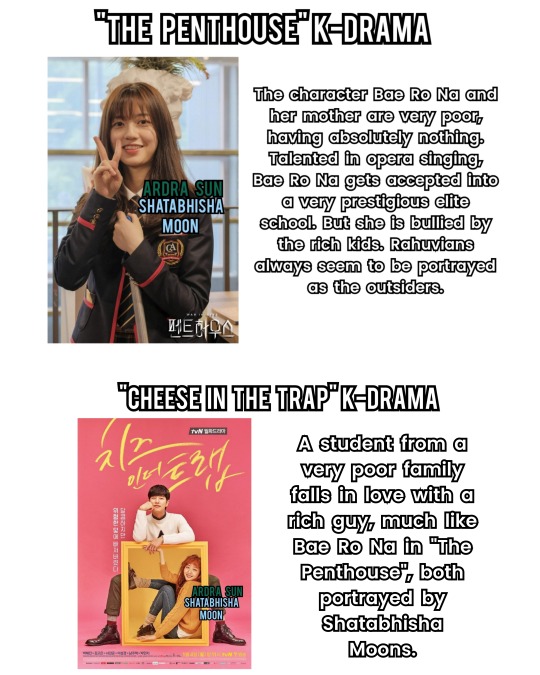
As I briefly gave examples in this post, Shatabhisha can be linked to Cinderella. Which means that trine nakshatras can also inherit this theme of person from poor background falls in love with person from wealthy background. As shown in that post, the union is often with a Mula native. It was expected to find these Rahu-Ketu connections, as the nodes are always one with each other. Their themes can overlap, which I'll be going more into further down this post.
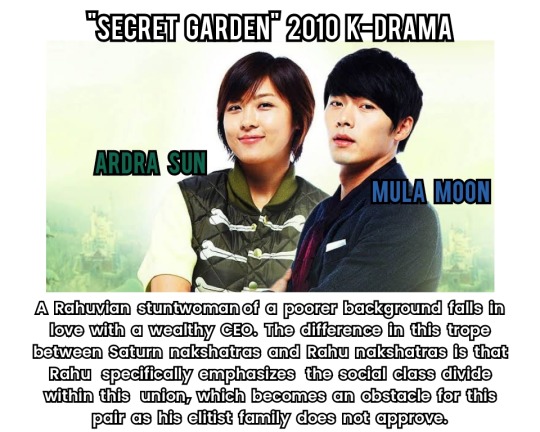
The Mula CEO also comes from old money.
Rahu thrives on venturing the unknown and embracing the unconventional, often shown in the trope of one falling in love with someone alien.
This otherworldly love is seen in Pirates of the Caribbean: On Stranger Tides, where a Rahuvian sailor falls in love with the mermaid, Syrena. Mermaids are captured and exploited by humans — immediately we see this theme of division. And unlike the other humans, he treats Syrena with respect and equality.
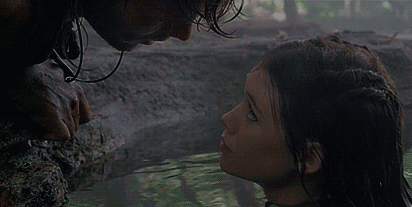
Syrena is portrayed by Mula Moon Astrid Berges-Frisbey, while the sailor is portrayed by Ardra Sun Sam Claflin. In the end, Philip becomes a merman and lives with Syrena underwater. This transformation that the Rahuvian goes through in order to unite with a lover of another species is also seen in the film Lisa Frankenstein, starring Shatabhisha Moon Kathryn Newton — although it's more in a Romeo-&-Juliet style.

The Rahuvian character, Lisa, falls in love with Creature, who is a living corpse portrayed by Magha ASC Cole Sprouse. Lisa kills herself in a tanning bed to join the Creature in death. Their union shows her alive, but mummified.
This theme of one overcoming the obstacle between them and the person they desire is seen yet again in the film Casper (1995). A girl, played by Magha ASC Christina Ricci, meets a ghost named Casper, who falls in love with her. Casper is voiced by Malachi Pearson who has potential Swati Moon. Casper's one wish is to be human again so that he can win her heart.
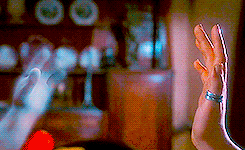
His wish is fulfilled but he can only be human up until midnight. His human form is portrayed by Swati Moon Devon Sawa.
In the Korean drama, Are You Human?, Shatabhisha Sun Gong Seung-yeon plays a bodyguard who is given an opportunity to protect an advanced humanoid whom she falls in love with. Another abnormal, interspecies relationship.
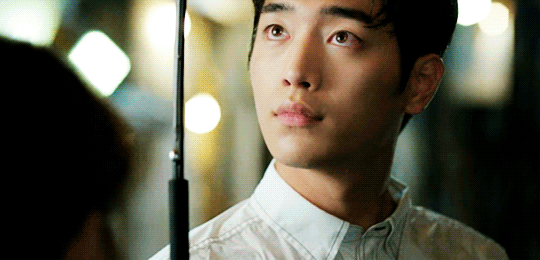
The humanoid is the clone of an heir of a rich conglomerate. The heir is portrayed by Magha Moon native Seo Kang-joon – him being born into wealth contrasts with her being brought up from a poorer background; we see this theme again of a cross over between two opposite worlds as she gets romantically entangled with him.
A lot of these pairings show Rahu's need to break taboos and seek authenticity over conformity, as these unions tend to be abnormal in a discriminatory society. As illusory as Rahu is by nature, it highlights the illusions within society and the challenges that come with it.

Rahu seeks to challenge conventions, forcing individuals to confront their biases, embrace diversity, and explore love in its most expansive ways; while Ketu can be detached from society in general, already transcending or dissociating from it altogether.
Now extending the old money archetype into this, we can see Rahuvians embodying this shabby, nonconforming, rough-around-the-edges, transformative archetype who'll be on the opposite end. As Ketu symbolizes the past, ancestral roots, tradition, the old way of doing things; Rahu symbolizes the future, foreignness, pursuit, a new way of doing things.
Old money often means adhering to strict family rituals, customs, and expectations. There's an expectation for the wealthy to marry their own, maintaining a cultural practice that has existed for centuries, a theme of Ketu as it means to preserve the past. But Rahu comes in as a disruptor, changing rules that seemed absolute, causing more confusion and tension. Rahu often seeks unity, even with our all differences.

Rahu and Ketu are always 180 degrees apart in a chart. This gives an understanding to how they're always on opposite sides of the same coin. So their union in these media examples often come with resistance and chaos.
The story of Romeo and Juliet is about a star-crossed love stuck in this push-&-pull between tradition and breaking free from tradition.

Rahu is symbolized as the head of a dragon, while Ketu is the tail. Together they remain in this endless chase, their nature defined by longing and separation. Maria and Tony from A West Side Story mirrors this nodal dynamic, as it's based on the classic Romeo and Juliet. Just as the nodes themselves are forever trapped in opposition and in an eternal chase, these lovers remain trapped by their differences. Their love and lives are destined to be cut short, signifying the impossible union between the opposing nodes in these forbidden love stories.

The tragic ending of Maria and Tony’s story reflects the inevitable nature of the nodes. In both Romeo and Juliet and A West Side Story, we see the power of love transcending societal barriers, yet this love is doomed by the very forces it seeks to overcome.


Ashwini nakshatra literally has the strongest ties in Romeo & Juliet (list).
Another pair of this nodal influence (Ketu-Ketu), with this exact theme, is Mavis and Johnny from the animation Hotel Transylvania. Mavis is voiced by Ashwini Moon Selena Gomez, and Johnny is voiced by Magha Sun Andy Samberg. Mavis is a vampire and Johnny is a human. Their worlds should never have had a crossover to begin with. But Johnny, being Magha, feels a sense of belonging with these monsters and Mavis instead of fearing them (a nod to the Mula archetype and Beauty-&-the-Beast trope, which, as I've stated before, can also manifest itself as Ketu-Ketu instead of Ketu-Jupiter... much like Belle and Rumpelstiltskin from Once Upon A Time, Belle being played by Mula Sun Emilie de Ravin and Rumpelstiltskin portrayed by Ashwini Sun Robert Carlyle — the show's own Beauty & the Beast).
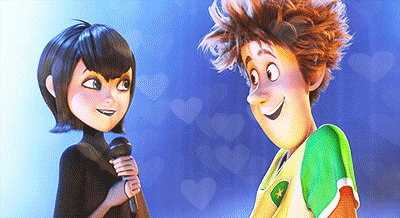
Though light-hearted and comedic, their union was forbidden as monsters and humans should be kept apart to their own worlds due to past conflicts. Mavis' father, Dracula, goes to great lengths to separate the two, but then he realizes that their love is genuine and overcomes his prejudices.

The theme of letting go touches on Ketu's tendency to sever ties, signifying the lesson of how temporary things are, including love. The film Untamed Heart is a great example, perfectly encapsulating this theme between two Ketu natives.

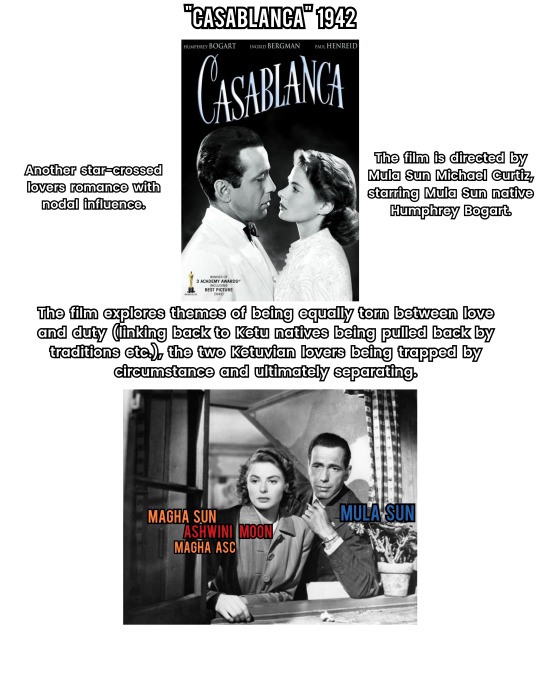
And as Mars also rules Ashwini nakshatra, this can be a major focus.
Connecting Orpheus to Ashwini, so much of this nakshatra's themes are highlighted in this Greek myth. Ketu is associated with nature, animal caretaking, and taming wild beasts. This is seen in Orpheus's ability to charm animals, move trees and rocks, and even change the course of rivers, through his music. Music has been known as a form of comfort and healing, and Orpheus' music is so powerful that it hypnotizes wild beasts, even influencing Hades, the ruler of the underworld.
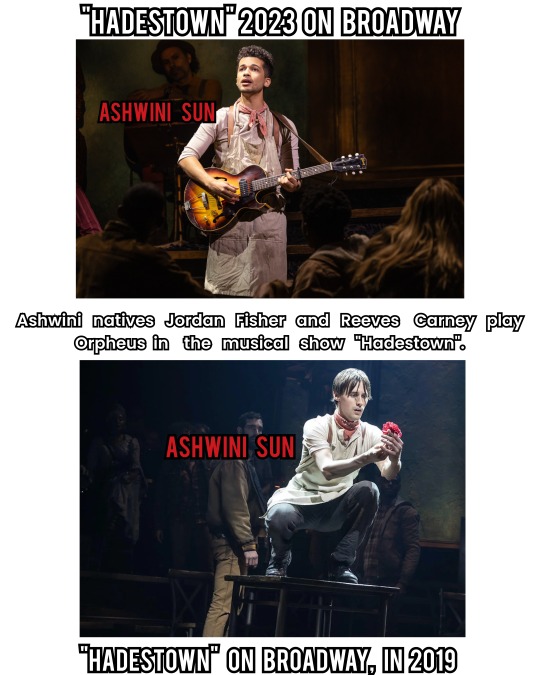
The mythological character loses the love of this life, Eurydice, and he is unable to accept her death. He becomes so desperate, filled with grief and fear, that he descends into the underworld to get Eurydice back. As Ashwini can be driven by selfishness, severance becomes a major lesson in their journey.
The musical film Black Orpheus (1959) is directed by Ashwini Sun, Magha ASC Marcel Camus, a black Brazilian retelling of the tale.
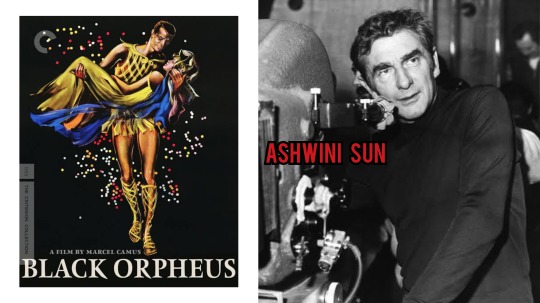
In Jason & the Argonauts (2000), Ashwini Moon Adrian Lester portrays Orpheus. In the animation Hell and Back, *Ashwini Moon Danny McBride voices Orpheus. In 1960s The Giants of Thessaly, Massimo Girotti portrays Orpheus and he has Moon in Magha (trine nakshatra to Ashwini). This obvious connection of Ashwini to Orpheus takes me back to the ruling deities, the Ashwini Kumaras. Ashwini can be related to partnership, soulmates, connected minds. Here, there's a theme of inseparability yet the nature of the nakshatra forces severance. Back to the tale — With just the charm of his music, Orpheus is able to convince Hades to bring Eurydice back to life, only under the condition that Orpheus never looks back at her when they leave the underworld. Overwhelmed with so much love, he's unable to help himself, as he fails and looks back at her as they neared the exit. This is how Orpheus loses Eurydice forever.
Similar to Orpheus, the Twelfth Doctor from Doctor Who spirals into madness and desperation after the death of his close companion, Clara Oswald. The Twelfth Doctor is played by Ashwini Sun native Peter Capaldi. His Aries relentlessness and selfishness has him breaking the laws of time to bring her back, just like Orpheus breaks the natural order of life to get Eurydice back.
Clara Oswald is interestingly nodal herself, being played by Ashwini native Jenna Coleman.
YouTube video link
His journey through grief and his refusal to let her go mirrors Orpheus's determination to challenge the natural order of life for love. In the end, Twelve's memories of Clara get wiped out when he is forced to sever ties with her. Clara remains dead and so does Eurydice. This makes these pairs star-crossed, as Ketu reminds us of the inevitability of loss and separation. With Mars there, it makes it an obvious theme with Ashwini nakshatra.

Orpheus tried to get Eurydice back after her death by seeking the realm of the dead as a mortal being. He finds the cave that led to Hades and slowly descended into the Underworld. He sang to Cerberus, a terrifying, three-headed monstrous watchdog, able to tame and charm the beast so that he enters. This theme of entering portals to other worlds and dimensions tends to be associated with Ketu, and I find it interesting that I am particularly seeing the magic within Ashwini nakshatra.


In the 2008 film Jumper, Ashwini Sun Hayden Christensen plays a young man who can teleport himself anywhere and everywhere due to a genetic anomaly.
It is interesting that Ketu nakshatras also have this otherworldliness quality to them which is seen in having access to portals or dissociating into other realms. Although I have already explored this theme within the context of Anuradha nakshatra, there is still an undeniable nodal influence to it as I see these nakshatras frequently pop up in this genre of film.

Magha Sun Amy Adams' character in Enchanted falls into a well which is a portal to another world. In Alice in Wonderland (2010), Magha Moon and Swati Sun native Mia Wasikowska's character also falls into a portal to another world.

In the animation Caroline, Ashwini ASC and Shatabhisha Sun native Dakota Fanning voices a girl who finds a portal to another world. In 1953's Peter Pan, Ardra Sun Kathryn Beaumont voices Wendy who is taken to another magical world called Neverland by a boy named Peter Pan who's voiced by Shatabhisha Sun Bobby Driscoll. In 2003's Peter Pan live-action movie, Wendy is played by Ardra Moon Rachel Hurd-Wood, taken into this whole other reality of magic and wonder. In Hook (1991), adult Peter Pan is portrayed by Shatabhisha Moon and Swati ASC Robert Williams, the character a middle-aged lawyer from the modern world who returns to his magical origins. In the Korean drama Spice Up Our Love, Ashwini Moon Han Ji-hyun's character wakes up as the protagonist of the web novel she wrote. In the Korean drama W: Two Worlds Apart, Shatabhisha Sun Han Hyo-Joo gets sucked into a webtoon written by her father. There she falls in love with the protagonist who is played by Shatabhisha Moon Lee Jong-Suk, who gets gets sucked into her reality as well. In the Chinese drama Love Game in Eastern Fantasy, Mula Sun Esther Yu gets sucked into a video game novel as a supporting character. In The Wizard of Oz, Mula Moon and Ardra ASC Judy Garland plays a Kansas farm girl who is taken away in a tornado and ends up in the magical Land of Oz. In the series Emerald City, Ashwini Sun Adria Arjona is a Kansas nurse who is transported by a tornado to the Land of Oz. In the film Oz: The Great & Powerful, Ashwini Sun James Franco is a magician who is hurled away from Kansas into the wonderful land of Oz. In the 2013 animation Epic, Magha Moon Amanda Seyfried voices a young girl who finds herself transported into an alternate world and even falls in love with Ashwini Moon Josh Hutcherson's character (I highly recommend this film).
As Rahu is associated with illusions and exploring the foreign, we see this theme of escaping into simulations and dreamy worlds which one becomes absorbed in. This has been explored deeper within Swati nakshatra, which combines the arts and illusory tendencies of Rahu together.
The influence of the nodes often transcends the physical realm, embodying forces of spirituality, illusion and transformation together. But they both manifest differently in this theme. Rahu becomes absorbed in illusions (in form of the arts, simulations, imagination (ex. Peter Pan being the boy who is attached to Neverland because he never grows up — Neverland is an illusory place only found in the minds of children, this highlighting his attachment to illusions)); while Ketu tends to escape the material plane altogether, yearning transcendence and passing by realms to seek meaning and lessons.
In the film Meet Joe Black, Mula Sun Brad Pitt plays an otherworldly being who takes over the body of a man to experience Earth and be guided in the teachings & meaning of life. His very existence quite literally transcends time and space, which I relate to Ketu, as he is a mystery himself.
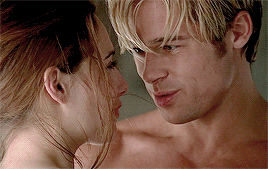
He is innately detached from human concerns like time, societal expectations, and permanence. But he falls in love with a human named Susan, who is also nodal-ruled, and his nature makes their connection doomed from the start. Susan is played by Mula Sun, Mula Moon native Claire Forlani. This making for another star-crossed pair because he can never fully participate in human life.
Going into the body-swapping trope, this calls to Rahu's desire to navigate a foreign perspective while Ketu seeks to transcend its rigid reality.
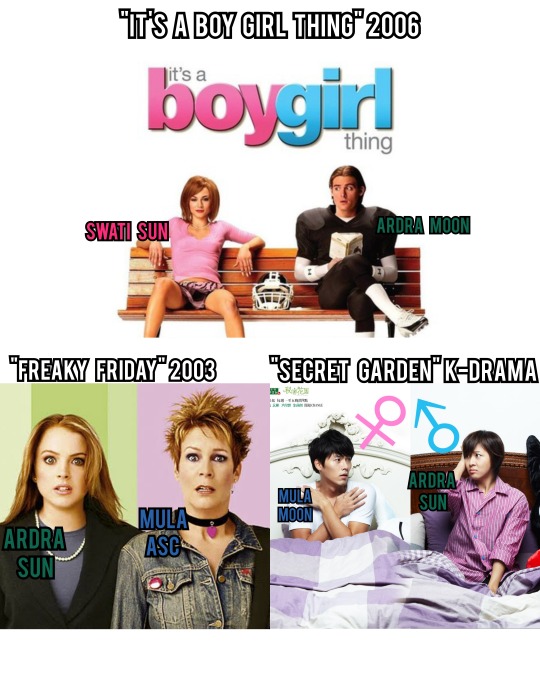
In the film Hot Chick (2002), Swati ASC Rachel McAdams plays a teenage girl who wakes up in the body of a 30-year-old male criminal played by Swati Sun and Ashwini Moon native Rob Schneider. In 1989's film Dream a Little Dream, an accident puts the consciousness of an elderly dream researcher played by Magha Moon Jason Robards into the body of a bratty teenager who is played by Mula Sun and Shatabhisha Moon native Corey Haim. Many more examples often include a Saturn nakshatra native as well, which I found very interesting. Hopefully I'll be circling back to that one day!
Rahu is thriving on the chaos of this trope since an entirely new identity is being explored (and lessons are learned as the social difference in one's gender, class, and even age tends to be highlighted for the ignorant one (Rahu essentially refining the native through this experience)).
The interaction of the nodes drive each other to a deeper understanding of life's illusions as it signifies letting go and refining oneself. In this little exploration, I got to understand that Ashwini is a romantic nakshatra which deals with loss and forced detachment due to Ketu. While Rahu nakshatras tend to be more romantic and igniting conflict in their pursuit of a love that's not right according to societal standards. This solidifies the image of the eternal chase of the dragon representing desire and detachment.
#ketu#rahu#nodes#mula#shatabhisha#magha#ardra#ashwini#swati#sagitarrius#gemini#libra#leo#aries#aquarius#vedic astrology#vedic observations#sidereal astrology#sidereal observations#astrology#astro notes#astro observations#nakshatra series
404 notes
·
View notes
Text
What I love about the press conference scene in Episode 10 is that Saeon just flat out doesn't give a crap about himself or his future because it's all about Hee Joo. In contrast to his carefully cultivated image as the spokesperson and a member of an elite family, he goes out there in front of the press unshaven and an emotional wreck.
The image of Hee Joo behind him mirrors her position in his world - she's everything. Her picture looms over him just as her love - and his love for her - encompasses everything about him. He will do anything to protect her including making himself smaller to put her first.

191 notes
·
View notes
Text
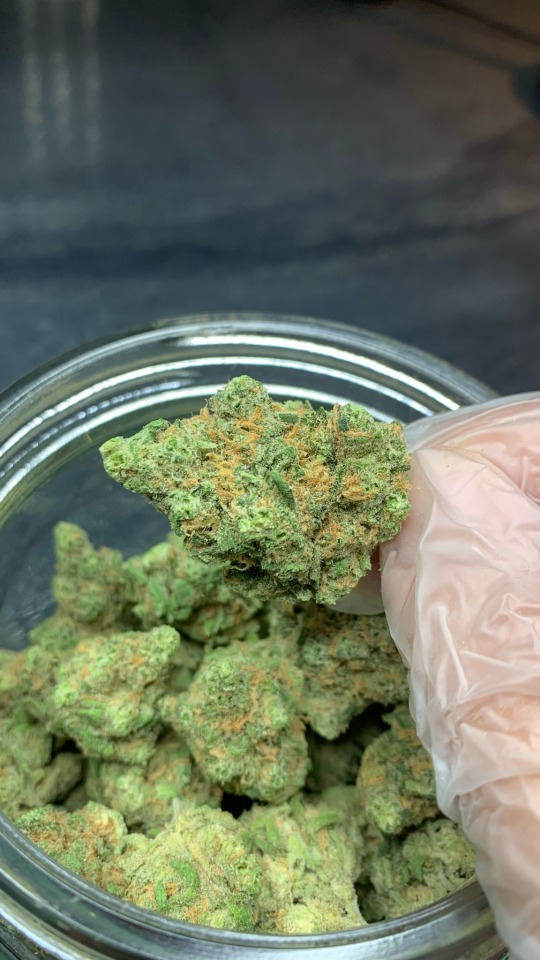


Strain: Blue Dream
Grower: Elite Cultivation
State: Oklahoma
Medical/recreational: Medical
#blue dream#cannabis#medical cannabis#cannabiscommunity#cannabis culture#cannabis content#cannabis community#weedstagram#smoke weed everyday#420daily#420life#420weed#420photography#girls who smoke weed#girls smoking weed#weed pictures#Elite Cultivation#Oklahoma#jothetender#mine
2K notes
·
View notes
Text
Herpespets sleep most of the time, but if you feed them with enough sunlight or stress, they can wake up and build little houses on your mucous membranes so you can trade with your friends!
everyone gets so mad about herpes when that's just a little guy that wants to hang out... it's like a tamagotchi inside of you...
#mostly unrelated but this gives me an idea for a sci fi thing#where there are viral strains that give people powers or whatever#and it's like herpes where its in most people for life and usually dormant in neurons#so people have to cultivate breakouts so they can use its power and spread especially desirable strains to other people#it doesn't even have to be powers actually#it can just be that the symptoms of the mostly harmless breakouts are socially desirable#like how moles are considered beautiful in some cultures#like imagine teens frantically trying to trigger breakouts of their favorite strains because the big dance is coming up#and they have to look their best#designer strains cultivated to be sold to brides so they can break out just right for their weddings#cosmetics meant to simulate the effect of different breakouts (of course considered cheap and tawdry)#some strains are considered more masculine or feminine#so powerful men have to be very careful not to trigger breakouts of the effeminate strains they got from their wives and mistresses#but they also need to keep their most virile strains broken out for important meetings and speeches and such#entire subcultures built around prizing the strains considered undesirable by most of society#once prestigious strains being excised from elite society when they mutate to be more contagious and spread to the wider population#wait this might actually be good
425 notes
·
View notes
Text

#cannabis community#cannabis#cannablr#Donny Burger#cannabis strain#cannabis strains#mine#cannabis content#Elite Cultivation#Oklahoma#medicinal herbs#medical marijuana#medical cannabis#cannabis cultivation#cannabis culture#wearyelfphotos#cannacommunity#cannalife#pretty bud#pretty nugs#1950s#weedlife#420friendly#60s#girls who smoke weed#marihuana#weedsociety#sativa#weed#kush
3 notes
·
View notes
Text
The hysteria surrounding South Africa’s land reform policies is, in part, fueled by the specter of “Zimbabwefication.” The global right has long used Zimbabwe’s land seizures of the early 2000s as a cautionary tale of what happens when black-majority governments challenge white property ownership. The narrative goes that Zimbabwe’s economic collapse was a direct result of land expropriation rather than a combination of mismanagement, corruption, and structural economic constraints. This crude analogy ignores fundamental differences: unlike Zimbabwe’s forced land seizures, South Africa’s Expropriation Act remains bound by constitutional provisions ensuring fairness and public interest. More importantly, the comparison assumes that black-led governments cannot administer land reform responsibly, reinforcing a racist paternalism that undergirds much of the right’s critique. The same ideological project is at work in the outcry over South Africa’s affirmative action policies. While it is true that employment and shareholding equity laws have been inconsistently applied and, at times, weaponized for cronyism, the broader claim that white South Africans are being systematically excluded from the economy is baseless. White South Africans continue to occupy the most lucrative positions in business, control the majority of private wealth, and benefit from generational economic advantages that decades of slow-moving transformation have failed to undo. Affirmative action, far from dismantling this entrenched inequality, has mainly served to cultivate a small black elite while leaving the structural dynamics of racialized wealth accumulation intact. But this is not what inflames Musk and his allies. Their real concern is not fairness or economic justice—it is the preservation of white economic dominance.
[...]
The imagined exodus of white South Africans fleeing “oppression” to build a new life abroad is an old fantasy, one that has circulated since the end of apartheid, but remains largely unrealized. The simple reason is that, despite the challenges, South Africa still offers a higher quality of life for many white citizens than the precarious existence they would face as economic migrants in the US or Europe. Their sense of victimhood, then, is not rooted in material dispossession but in a psychological discomfort with a country in which their hegemony is no longer unchallenged.
19 February 2025
129 notes
·
View notes
Text
honey's guide to spring⋆.ೃ࿔*:・🪷

i've been preparing this post for a while bcuz i LOVE spring and for this spring i just wanna embody feminine, fairy, dream-like beauty in my day-to-day this spring, and just enjoy it fully.
THE MOOD FOR SPRING : planting new seeds, fresh fruit, and bouquets of flowers. tea parties and floral prints and perfumes. green grapes, hibiscus tea and waking up early to see the sunrise.
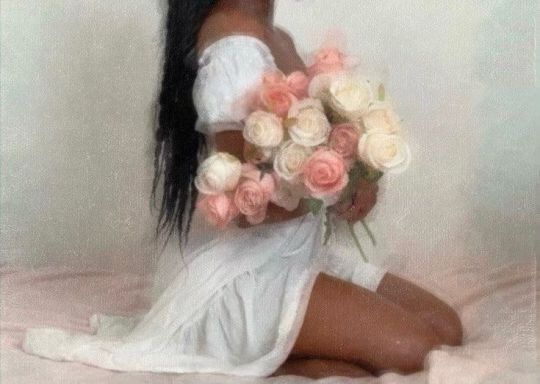
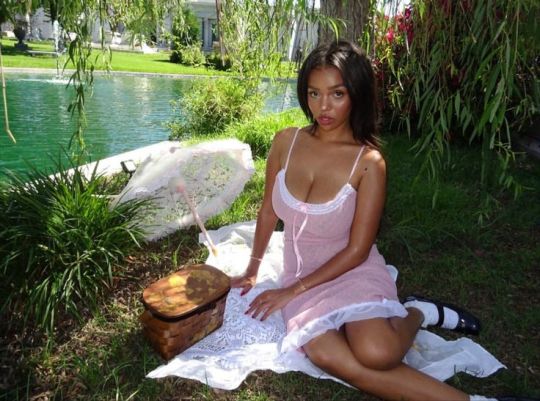
PREPARATION FOR SPRING : stock up on your favorite fruits and teas. if u want fruits that are in season, the fruits in season during spring include strawberries, cherries, blueberries, kiwis, bananas and nectarines. my favorite spring time tea is hibiscus and i love a good matcha during all seasons but especially spring, and lastly a good citrus tea is always something that i enjoy.
if ur someone who experiences rly bad allergies during the spring make sure that u go to ur doctors for a check up, and make sure that u have everything that you'll need to combat allergies.
THE PLAYLIST : a good playlist is always essential so my spring playlist consists of : eternal sunshine - jhene aiko. はるなつあきふゆ - ichiko aoba. afterglow - luna li. pisces - yerin baek. fairy of shampoo - TXT. scenery - red velvet. hydrangea love - TXT. cool with you - newjeans. salad days - iiso. pov - ariana grande. lyricist - heize.
REFRESH : time for spring cleaning both mentally and physically. analyze what habits are nourishing u and which habits are drying you out. analyze ur space and do a deep cleaning, that way u can feel lighter both mentally and physically.
wash ur sheets, maybe even buy fresh sheets (floral printed sheets for spring ofc)
go thru ur closet and put the winter and autumn clothes towards the back and bring the spring clothes where they're more accessible and visible


deep clean ur room and clean ur house -> get onto clean-tok for some cleaning motivation cuz watching videos of people cleaning and organizing always motivates me to do so too
create new pinterest boards and delete ones that u dont use, or if u want to, create a completely new pinterest account. i've grown attached to my pinterest account so i won't delete it, but i've made lots of other accounts on separate devices
oftentimes we forget to clean what we use the most, and that buildup can cause our tools to be counterproductive, and just carry a lot of unnecessary germs so here are some things not to forget to clean and organize ;
behind ur ears
ur earbuds or headphones
ur skincare tools and devices (gua shas, face rollers)
ur phone screen
ur folders, binders, and folders
CULTIVATING CREATIVITY :
create something - do some painting, start a sketchbook, start dabbling in some poetry, maybe write a short story, cultivate an elite playlist etc etc
connecting with nature - go and get some fresh air, wake up earlier than usual to watch and enjoy the sunrise. drink different teas that you've never tried before, go to a local crystal shop if ur into that, make urself an elaborate platter of ur favorite fruits. go for a walk in the park, pick flowers and speaking of flowers, go and buy urself a pretty bouquet.
create a spring-time mood board
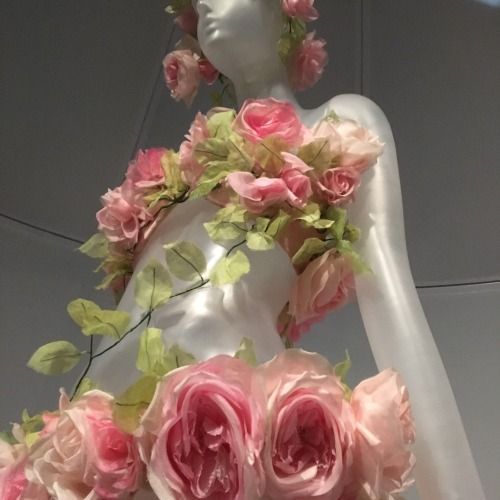

TENDING THE GARDEN OF THE MIND :
ofc i MUST talk about the mind in any of my posts bcuz its just so incredible. but what you think matters!! what u think manifests! the thoughts that u continue to water and entertain are what you will experience. therefore when u change ur thoughts and water the seeds of the new thought, you'll get a new flower.
its like gardening. your thought is the seed, and ur mind is the soil. when u entertain ur thoughts ur watering the seed, and you'll get a new flower, the flower is the new experience. so this spring, plant new thoughts and entertain those thoughts ✨
FUN SPRING-LIKE THINGS :
picking flowers -> buying yourself a bouquet
have a tea party by yourself or with friends (reference my tea party post if u need some inspo)
make a bracelet or anklet out of flowers
take a bath and infuse the bath with things like rose petals, rose scented bath milks etc
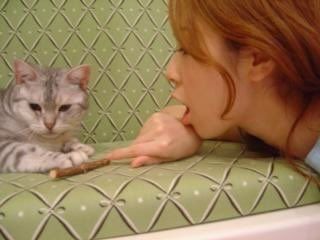
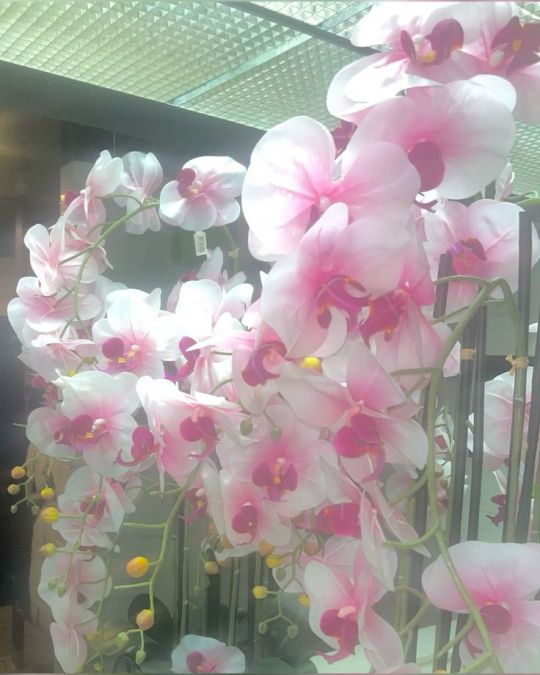
crystal shopping (last year i added amethyst to my crystal collection, this year i'd love to add selenite into my collection)
watch a 90's anime (i've watched sailor moon about a MILLION times and im gonna rewatch it again this year bcuz its just the girliest, best anime i've watched and is one of my favorites)
so i hope that this post sparked some ideas on ways that u can enjoy your spring girlies ✨
#it girl#becoming that girl#self care#that girl#it girl energy#honeytonedhottie⭐️#honeys guide to spring🪷#flowers#spring#dream girl tips#dream girl#dream life#romaniticization#romanitcize#music#mindset#girl blog#just girly things#girlblogging#girly#girly girl#hyperfemininity#soft spring#springtime#floral#flowercore#snowdrops#fairy#princess#my thoughts💬🎀
424 notes
·
View notes
Text
thinking about ancient society and how a civilization might cultivate something like mass ascension. i think itd be interesting if void baths required some sort of application and even a vetting process-- after all, if your occupation is too "essential", it would be more fitting for you to stay behind and care for your society until more people are gone, wouldn't it? like surgeries, you probably get shoved into a wait list even after acceptance and have to wait months to actually get a bath reservation (i imagine they'd book a private bath room and do some sort of ceremony with friends and family present for the ascension) of course all the wealthy elites would be jumping forward in line and get into the baths immediately. moon mentions the baths being "cheaper," so price is baked into them from the beginning. i think it would absolutely be a class thing--- only the wealthy get the privilege to move on from the world, and the working class are stuck continuing to care for the city and their iterator until the population shrinks enough. it would be interesting to think about how counterculture and class warfare would cultivate in such a setting, where moving on from the world is seen as desirable but the poor are denied it. void baths would probably have really beefed security, and i bet many people tried to break into them at some point or another. fun to imagine social movements calling for government regulation of void bath prices. maybe there were even private corporations who advertised "cheaper void baths" that turned out to be some kind of acid or other fluid that wouldn't ascend you but would certainly injure you.. idk just many interesting things to think about
354 notes
·
View notes